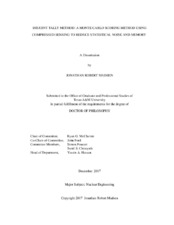| dc.description.abstract | We present a methodology for using compressed sensing concepts to compute a global
solution for Monte Carlo simulations with less memory and an accelerated reduction in
statistical noise. The methodology utilizes a process known as total variation
minimization to reconstruct the solution from the projection of the scoring array onto
randomly constructed basis sets.
In the disjoint tally method, the memory allocation of the basis sets and the projection
is a fraction of the size of a standard scoring array and is a replacement for the array
at runtime. Memory reduction results are approximately 25% for 1 thread and 1 tally
quantity, ~ 35% for 16 threads and 1 tally quantity, and can exceed 75% at 16 threads and
8 tally quantities.
The reconstruction method is peak-preserving and applies statistical denoising upon
reconstruction. If a satisfactory global solution to scoring array A can be reached at fvN,
where N is the number of particles simulated and i € 1; . . . ;N, then if Δi is the
difference between fvi and fN, our method at fi consistently produces a smaller Δi than a
standard scoring array at fi. Since N is arbitrary, the disjoint tally method effectively
decreases computation time by producing results at fvp where i < p < N.
We begin by introducing the concept of disjoint tallies and provide the procedure for
local reconstruction on subsets of the global mesh. We present evidence of the validity of
the solution produced by the methodology and the reduction in memory footprint via
direct comparison to a memory-efficient storage implementation within the Monte Carlo
transport toolkit, Geant4. Additionally, we present a method for reconstructing statistical quantities in the form of the variance, relative error, coefficient of variation, and
root-mean-squared. Results are given for three different global reconstruction scenarios:
a reactor bundle, a neutron shielding problem, and set of CT scans rendered directly from
DICOM files.
We believe the demonstration of the significant reduction of data allocation size, the
evidence of acceleration towards the bounded total variation of the solution, ability to
reconstruct the quantities required for statistical checks, and the local nature of our
reconstruction will provide capabilities necessary for high-fidelity exascale
computing. | en |


